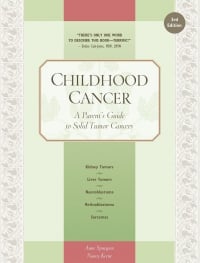Childhood Cancer
Goal setting and treatment planning
A difficult but necessary step in making plans is discussing and deciding on your and your child’s goals. Health Canada’s publication, This Battle Which I Must Fight: Cancer in Canada’s Children and Teenagers, states:
This [recurrence] is a time of crisis and ambivalence. The decision to be made is whether to continue to try to achieve a remission or to replace this hope with the hope for comfort for the child and a special time together. Each parent, and the child who is old enough to understand, requires differing amounts of time to reach a decision about how to proceed. Careful and frequent discussions with the medical team, as well as with trusted friends and relatives, may help clarify issues and bring some peace of mind.
In a newsletter for parents of children with cancer, Arthur Ablin, MD, (Professor Emeritus of Pediatric Clinical Oncology at the University of California, San Francisco), wrote of the importance of goal setting in the decision-making process after recurrence:
Before determining which treatment is to be chosen, a decision must be made to determine the goal of treatment—in other words, what is it that we are trying to achieve. This crucial first step is the basis upon which any decision concerning treatment must be made. But it is too often omitted from consideration and/or discussion, even by the most experienced. The frustrations accompanying the previous failure of treatment, the fear of the loss of the hope for cure, the pressure of urgency to find solutions, the new awareness of the possibility or probability of death, lead us all to want to consider treatments first rather than these more difficult considerations involved in establishing goals. These also force us to deal with reality earlier, which could mean the almost intolerable confrontation with the death of a very-much-loved child, a tragedy to be avoided at all costs.
If after discussion of goals your family decides to pursue aggressive treatment, there may be more than one option available. Therefore, it is important to understand the treatment avenues that are open to you. Treatment plans for a first recurrence may be specified in the standard treatment or clinical trial protocol document, or your child’s oncologist may suggest a different approach. Suggestions for treatment may include surgery, radiation, stem cell transplantion, more intensive chemotherapy, immunotherapy, a clinical trial, or a combination of several treatments. You may need to weigh traveling to a different treatment center to gain access to therapies that are not available at your child’s home hospital.
Do not rush into treatment if you or your family feel uncomfortable about the plan. There is always time to obtain answers to all of your questions and to get a second opinion. Doctors make recommendations based on knowledge, experience, and consultations with other experts in the field. Do not hesitate to ask your child’s oncologist why she has suggested a certain treatment approach. Ask the doctor about treatment goals, methods, and possible side effects. Also ask if she has consulted with others in the decision-making process, and if so, with whom. Be certain older children and teens are involved in decisions about their care and treatment choices.
Making the decision as to what treatment to choose was much more difficult when my son relapsed. The stakes were higher. While I had faith in the skills and judgment of my son’s oncologists, I could not rest easy unless I had educated myself on the options available for relapse treatment. His relapse had been suspected for weeks, so I had time to investigate possible treatment choices. His relapse site was rare, which made the usual channels less effective in our case. I started with the online NCI-PDQ and a PubMed search. I asked friends to search for me. From there I contacted a physician from a leading children’s oncology research group and asked what type of treatment protocol they had to offer for my son’s type of relapse. I learned that the options were few in terms of protocols addressing my son’s type of relapse.
When we sat down with the treatment team, I already had some background and knew what was available in terms of treatment. When they presented their choice of protocol, I asked for and was given a copy of the protocol. Reading the rationale and background of the study they were proposing helped me to understand why this protocol was suggested. As a result, I was able to make a difficult decision and enroll my son in a clinical trial with confidence that he was getting the best treatment available. Since it was a very difficult and intense treatment protocol, it also helped my teenaged son to understand why this was the path we were following. Once begun, neither of us had any serious doubts that we’d made the best choice. Now, almost 3 years later, I am still very pleased that I was able to make a fully informed decision.
Table of Contents
All Guides- Introduction
- 1. Diagnosis
- 2. Bone Sarcomas
- 3. Liver Cancers
- 4. Neuroblastoma
- 5. Retinoblastoma
- 6. Soft Tissue Sarcomas
- 7. Kidney Tumors
- 8. Telling Your Child and Others
- 9. Choosing a Treatment
- 10. Coping with Procedures
- 11. Forming a Partnership with the Medical Team
- 12. Hospitalization
- 13. Venous Catheters
- 14. Surgery
- 15. Chemotherapy
- 16. Common Side Effects of Treatment
- 17. Radiation Therapy
- 18. Stem Cell Transplantation
- 19. Siblings
- 20. Family and Friends
- 21. Communication and Behavior
- 22. School
- 23. Sources of Support
- 24. Nutrition
- 25. Medical and Financial Record-keeping
- 26. End of Treatment and Beyond
- 27. Recurrence
- 28. Death and Bereavement
- Appendix A. Blood Tests and What They Mean
- Appendix B. Resource Organizations
- Appendix C. Books, Websites, and Support Groups

